| A |
|
| Agouti
 
|
The banding of the hairs, which is caused by the gene A (Agouti-gene). The bands are yellow,
in silver varieties the bands are silver-white .
In general each single hair has 3-5 bands. |
| Autosomal |
Independent from the sex.
This term is used in genetics, when speaking of autosomal inheritance, i.e. sire and queen may inherit a trait. |
| B |
Goto Top |
| Belly spot |
A dark spot in the lower abdomen in cats with Siamese-points, which is coloured in the colour of the points.
A belly spot is considered as a fault. |
| Ringed |
See rings. |
| Bicolour
See also Piebald. |
Is a pattern with white patches, which is caused by gene S (Piebald Spotting).
In particular it denotes a specific pattern, where the amount of white is 1/3 (minimum) up to 1/2 (maximum),
the remaining coat is solid coloured or has a tabby pattern.
See the menu Standard-Colours-Distributionfor further description. |
| Blaze |
A white patch between the eyes, starting on the forehead and mostly extending down and besides the nose.
Bicoloured and Tricoloured cats often have a blaze. |
| Blotched
(classical tabby)
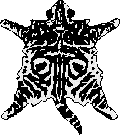
|
Denotes a specific tabby pattern.
The marking of a butterfly on the shoulder blades and the "bull's eye" on the flancs are characteristic for this pattern.
|
| Bobtail |
Certain cat breeds are called Bobtail, whose tail is extremely shortened and mostly has curves and/or kinks,
due to a natural gene mutation. In some cat breeds the tail looks like a pompom.
Examples having a pompom:
Japanese Bobtail
Karelian Bobtail
Kurilian Bobtail
Examples without a pompom:
American Bobtail
Mekong Bobtail |
| Break |
A very strong indentation between the forehead and the begin (base) of the nose, which is, compared to the Stop,
not rounded. |
| Brindling |
These are single white or lighter coloured hairs interspersed in otherwise solid coloured areas of the coat.
For example in the dark mask of a seal Siamese, or lighter coloured hairs in a black tabby pattern. |
| Brindled hairs |
White, lighter or darker coloured hairs in Self (solid) cats or in the coloured areas of a coat pattern.
For example: white or light coloured, but also dark coloured hairs in red/cream cats, single white or light coloured
hairs in the coloured areas of bicoloured cats. |
| Brush
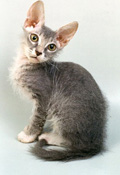
See also Velour. |
This is a type of coat in the Don Sphynx and Peterbald.
Usually Don Sphynx and Peterbald are nacked. But there is a coat type which has wavy, quite stiff short hairs,
uneven and with bare patches on the head, the neck and the back. These cats are used for breeding, not for showing. |
| Butterfly (markings) |
In blotched tabby cats a marking in the shape of a butterfly with both wings, upper and lower wings, can be clearly
seen on the shoulder blades. |
| Buttons |
The spots on the belly in tabby varieties. |
| C |
Goto Top |
| Calico
See also Tricolour. |
In some American organizations Tricolour is called Calico. |
| Cameo |
In some organizations red shaded and red shell is called Cameo. |
| Caramel |
Is a specific colour variety, which is caused genetically in blue, lilac and fawn cats and which causes the colour to
have a cold, metallic tone.
Caramel exists only in diluted colours.
This colour can be seen for example in the Australian Mist, but also in the Siamese. |
| Category |
See Hair category. |
| Cinnamon
Siehe auch Sorrel. |
In Abyssinians and Somalis the colour cinnamon is called sorrel. |
| Cobby |
short, massive and stocky body type is called cobby. |
| Colourpoint
See also Himalayan. |
Cats with Siamese-points are called Colourpoint. The best-known cats are the Colourpoint Persian, but also the
Colourpoint British Shorthair.
In the Siberian Cat colourpointed cats are called Neva Masquerade. |
| Cryptorchid |
A male is called to be cryptorchid, if none of the testicles has descended into the scrotal sack. |
| Curling |
Hairs may be curled, as for example in the Rex cat.
The term is also used for ears, which are curved backwards, as for example in the American Curl. |
| Ch |
Goto Top |
| Champagne |
The colour chocolate is called champagne in some cat breeds.
Example:
Tonkinese |
| Chestnut |
The colour chocolate is called chestnut in some cat breeds, and also in some organizations.
Example:
Havana (Brown) |
| Chinchilla
See also Shell.
See also Tipping.
A pattern in silver varieties. |
Is a coat pattern in agouti cats with an extremely high amount of silver: 7/8 of the entire length of the hair
shaft is silver-white, only the tip of the hair is coloured.
The colouring of only the hair tips is called Tipping (tipped).
There exist (Silver) Chinchilla and Golden Chinchilla. |
| D |
Goto Top |
Diluted
Dilution
|
| non-diluted colours |
diluted colours |
| black, seal |
blue |
| chocolate |
lilac |
| cinnamon |
fawn |
| red |
cream |
|
| Dominant inheritance |
If only one gene in a gene pair for a specific trait is sufficient to see this trait also in the external
appearance of the cat. |
| E |
Goto Top |
| Ebony |
Black Oriental Shorthair are called Ebony. They have green eyes. |
| Entropion |
When the eye lids are rolled inwards. |
| Extremities |
Extremities are:
|
| F |
Goto Top |
| FCK |
Flat Chest Kitten syndrome
The chest in kittens is flattened or depressed. |
| Flame point |
In some organizations Red point is called Flame point. |
| Flamme |
A cream or red patch between the eyes in tortie varieties, which starts at the forehead and mostly extends over
the nose. |
| Flocked |
See Velour. |
| Foreign White |
Completely white Siamese (without points) are called Foreign White. The eyes are deep blue.
Please note that in some organizations also the white Oriental is called Foreign White. The eye colour can be: blue,
gold, green, odd-eyed. |
Frost
Frost
point |
In some organizations the colour lilac is called Frost in some breeds. |
| G |
Goto Top |
| Gauntlets |
The white marking on the back side of the hind paws, which ends in a point, is called gauntlets.
The best-known breed, which must have gauntlets, is the Birman cat. |
| Genotype |
The genetic constitution of a cat, which can be seen in the external appearance of the cat, or not. |
| Ghost markings |
Are tabby markings in non-agouti varieties, which are mostly weaker and have less contrast, and which are undesired.
Examples:
red cats
smoke cats |
| Gloves |
The white markings on all 4 paws are called gloves. The white colour is absolutely pure white, and it may end at the
roots of the toes or at the joint.
In Birmans the gloves are defined very clearly, how far they are permitted to extend. |
| Ground colour |
Is the basic colour of the coat, on which the pattern is imposed.
Examples:
- black tabby: ground colour is golden-brown, the pattern is black
- blue golden shaded: ground colour is oat-meal coloured, colour of the pattern (tipping) is blue
- sorrel: ground colour is apricot, the ticking is red-brown
|
| H |
Goto Top |
| Hair category |
These are the four categories, into which the breeds are grouped in the WCF:
- Longhair - LH
- Semi-Longhair - SLH
- Shorthair - SH
- Siamese-Oriental Shorthair - SOSH
|
| Harlequin |
Is a pattern, which is caused by the gene S (Piebald Spotting), and where the amount of white is 5/6.
There are coloured patches (3-5 patches) on the head and the body, the belly is white.
There exist Bicolour and Tricolour Harlequins. |
| Havana (Brown) |
In some organizations the chocolate Oriental Shorthair is called Havana Brown.
In some organizations the Havana is its own breed, whose standard differs somehow from that of the Oriental. |
| Heterozygous |
If both genes in a gene pair for a specific trait are different from each other, the cat is called to be heterozygote
for this trait. |
Himalayan
See also Colourpoint. |
In some organizations the Persian Colourpoint is called Himalayan.
In some organizations the Himalayan is its own breed. |
| Hot cream |
Cream, which is too reddish in tone. |
| Hybrid
|
A cat resulting from a cross breeding between different breeds. |
| I |
Goto Top |
Inbreeding
Inbreeding coefficient |
Inbreeding is a method of reproduction, where 2 more or less closely related individuals are mated, i.e. at least they
have one common ancestor.
The inbreeding coefficient is the probability that two alleles, which are located at the same locus for this individual,
will be identical in its ancestry (i.e. inheritance of the same allele because of common ancestors). |
| L |
Goto Top |
| Lavender |
The colour lilac is called sometimes lavender in some cat breeds.
Examples:
Ôcicat
Oriental lilac, is called Oriental lavender in some organizations. |
Lethal
Lethal-factor |
An allele is said to be lethal, if homozygous kittens already die as foetus or shortly after they are born.
Example:
Gene M, homozygous Manx/Cymric would die before their birth, therefore Manx and Cymric are always heterozygous
for the gene M. |
| Longie |
Manx/Cymric with normal tail length are called Longie. |
| Lynx-point
See also Tabby point. |
Tabby point.
The points are striped. |
| M |
Goto Top |
| Mackerel
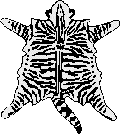
|
Denotes a specific tabby pattern.
The vertical stripes running from the back down to the belly are characteristic for this pattern. |
| Marbled |
A specific tabby pattern, which is derived from the classic tabby pattern, but where the pattern is broken up.
Lighter centers, coloured in the ground colour, are encircled by the dark colour of the pattern.
The best-known breed, which may be marbled, is the Bengal. |
| Mascara |
The rims around the eyes, which are coloured in the darker colour of the pattern:
- in the silver varieties shaded and shell, silver tabby
- and in tabby varieties.
|
| Mask |
Is a part of the points in (Colour)pointed cats, which has the shape of a rhombus and covers the face, including
the whisker pads and the chin. The mask is connected to the colour of the ears by traces of the colour. |
| Mask-factor |
Mostly the gene for Siamese points is called mask-factor. |
| Medallion |
Is a white patch on the throat, which is mostly considered to be a fault.
This white patch is not caused by the Piebald Spotting gene! |
Metacarpus
Metacarpal-pads |
The 5 bones of the front paws between the toes and the arch.
The small pad, located in the middle of the back side of the front paw and located above the third joint, is called
metacarpal pad. |
| Mi-Ke |
Mi-ke is the traditional colour tortie with white (tricolour) in the Japanese Bobtail. |
| Mink |
The colours of Tonkinese-points are called Mink. |
| Mitted |
Cats having the pattern mitted have white gloves on all four feet.
In certain breeds (Ragdoll, Snowshoe) a certain pattern is described as mitted in the standard. |
| Monorchid |
A male, which has only one testicle descended into the scrotal sack, is called to be monorchid. |
| Morphology |
The overall shape and build of the body is called morphology.
There are different body types according to the morphologic system:
- cobby
- semi-cobby
- foreign
- semi-foreign
- long and powerful/athletic oriental
|
| Mutation |
A mutation is a distinct change of a gene, which results in a new allele.
Examples:
Gene hr in the Sphinx causes the hairlessness.
Gene re in the Devon Rex causes the curled coat.
Gene Cu in the American Curl causes the ears to be curved backwards.
Gene Se in the Selkirk Rex causes the curled coat. |
| N |
Goto Top |
| Nanism |
dwarfism |
| Natural mink |
Synonym for the colour seal mink. |
| Necklace |
The stripes (rings) on the throat in tabby varieties. |
| Nictitating membrane |
The third eye lid in the inner angle of the eye, which may spread diagonally over the eye ball to protect the eye.
When cats are sick, one can see the third eye lid quite often, which is called prolaps. |
| O |
Goto Top |
| Odd-eyed |
Both eyes have a different colour, where one eye is blue, the other is yellow/green/orange.
White or bicoloured cats may be odd-eyed. |
| Oligodactyl |
The cat has too few toes. |
| Over shot |
When the upper jaws extend beyond the lower jaws. |
| P |
Goto Top |
| Parti-colour |
This term has two different meanings - which is confusing:
In some American organizations the tortie colours are called parti-colour.
In other organizations the colours with white (bicoloured) are called parti-colour. |
| Patched tabby |
In some organizations tortie tabby (frequently tortie blotched and tortie mackerel together) is called patched tabby. |
| Peke face |
Mostly these are red and red tabby Persians/Exotic Shorthairs with an extremely short nose, recognized in
some
American organizations.
The term is derived from the Pekinese. |
| Pewter |
A silver shaded/shell cat with orange eyes is called a Pewter. |
| Phenotype |
The external appearance of the cat. |
| Piebald Spotting |
The patching with white colour, caused by gene S, is called Piebald Spotting. |
 |
 |
 |
 |
 |
| 1 |
2 |
3 |
4 |
5 |
| Bicolour |
 |
 |
 |
 |
 |
| 6 |
7 |
8 |
9 |
10 |
| Harlequin |
Van |
|
| Pinch |
Is a clearly visible indentation at the base of the muzzle to the cheek bones. |
| Plantar |
The back side of the paws is called to be plantar. |
| Plantar patch |
Is a patch, coloured in the colour of the pattern, on the back side of the paws. |
| Platinum |
The colour lilac is called platinum in some cat breeds.
Example:
Tonkinese |
| Points |
All pointed cats - cats with the gene-combination cs cs, cb cb or cb cs - have points. The colour is restricted
to the face (mask), the ears, the legs and the tail. |
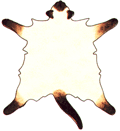 |
Siamese-points - gene-combination cs cs; these points can be seen in Siamese, but also in Colourpoint.
The body is not coloured, it is mostly off-white.
The eye colour is deep blue. |
 |
Burmese-points - gene-combination cb cb; Burmese are cats with points, but the contrast to the body colour
is very weak. |
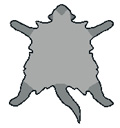 |
Tonkinese-points - gene-combination cb cs.
The body is coloured with the colour of the points, but the points are clearly visible, because they are darker.
The eye colour is aquamarin. |
| Polydactyl |
The cats has too many toes. |
| Prognatism |
Is the protruding of one jaw over the other, either the protrusion of the upper jaw over the lower jaw,
or vice-versa. |
| R |
Goto Top |
| Recessive inheritance |
If both genes of a gene pair for a specific trait must be equal that this trait can be seen in the external
appearance of the cat. |
Ringed
Rings |
A tail is said to have rings, if it shows distinct, "darker" coloured rings. |
| Rosettes |
Are spots, which are broken up and which have a lighter coloured centre, which is encircled by the darker
colour of the pattern (in different colour shades of the pattern).
The best-known breed, which should have rosettes, is the spotted Bengal |
| Ruddy |
Black ticked tabby in the Abyssinian and Somali. |
Ruff
Also called frill. |
The distinctly more and longer hairs around the neck are called ruff.
|
| S |
Goto Top |
| Sable |
The colour black = brown is called sable in the Burmese. |
| Seal |
The colour black in cats with Siamese-points is called seal.
Examples:
sealpoint
seal tortiepoint |
| Self
See also Solid. |
Coloured with one colour. |
| Sepia |
The colours, based on the Burmese-gene, are called Sepia. |
| Shaded |
Denotes a pattern in agouti cats with a high amount of silver or golden (about 2/3 of the entire hair length),
1/3 at the tips of the hairs is coloured.
There exist Silver shaded and Golden Shaded.
A special colour in GCCF are Asian shaded Standard (shaded without silver), that means 2/3 of the hair
shaft are paler coloured, the tips of the hairs are dark coloured. |
| Shell
See also Chinchilla. |
Denotes a pattern in agouti cats with an extremely high amount of silver or golden (about 7/8 of the entire hair length).
Only the hair tips are coloured.
There exist Silver shell and Golden shell |
| Silver
 |
 |
 |
 |
| shell |
shaded |
smoke |
silver
tabby |
|
The Inhibitor-gene I causes that the undercoat is silver-white and that the colour is restricted to the upper part of the
hair shaft of the upper coat.
In agouti cats the yellow bands become silver-white. |
| Silver tabby point |
When the agouti points (tabby point) have a silver-white basis. |
| Smoke point |
When the non-agouti points have a silver-white basis. |
| Solid
See also Self. |
Coloured with one colour. |
| Sorrel |
The term for the colour cinnamon ticked tabby in the Abyssinian and Somali. |
| Spine line |
A darker line (in the colour of the pattern) in tabby cats, which runs from the shoulders along the spine up to the tail tip.
|
| Spotted
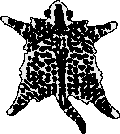
|
Denotes a tabby pattern with spots.
The spots may be round or oval and cover the entire body and the legs.
A special shape of spots are Rosettes.
|
| St |
Goto Top |
| Sternum |
Breast bone.
A long, flat bone in the centre of the chest to which the ribs are connected. |
| Stop |
A distinct indentation between the forehead and the base of the nose, which is rounded. |
| Strabism |
Squint. |
| Straight |
Mostly used to indicate straight ears.
Example:
Scottish Straight (Scottish Fold with upright, straight ears)
But also used in the American Curl, when the ears are not curled backwards and are straight.
The term is also used in breeds with curled hairs, when the hairs are straight.
Example:
Selkirk Rex straight |
| T |
Goto Top |
| Tabby |
Tabby cats are agouti cats which display tabby markings. Cream/red cats are an exception from the rule,
they may display a distinct tabby pattern without having agouti
There exist the following tabby patterns:
- Blotched (classical tabby)
- Mackerel
- Spotted A special form are Rosettes.
- Marbled
- Ticked
|
| Tabby point |
The points have stripes. These cats also have Agouti. |
| Tail defect |
The following deformations in the tail:
- kink The kink must not be only at the end of the tail!
- knot at the tip of the tail
- nervous knot at the tip of the tail
- greasy lump
- thickening of the tail tip due to a surplus of Calcium
- stiff end of the tail
- any malformation of the tail
|
| Texture |
The consistency of the coat.
For example:
smooth coat, silky coat, soft coat, firm coat, plushy coat, elastic coat, coarse coat |
| Ticking
ticked
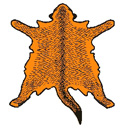
|
The bands of colour, which appears on each single hair, are called Ticking.
For example: Abyssinian, Somali have Ticking, Ticked Tabby Oriental. |
Tipping
tipped |
The darker colour, which is restricted only to the hair tips, is called Tipping (tipped). The remaining hair shaft
is lighter coloured.
Smoke, Shaded and Shell have Tipping. |
| Torbie |
Schildpatt gestromt. |
| Torbie |
Tortie tabby. |
| Tortie(shell) |
The colour is patched with red/cream patches. |
| Tricolour
See also Piebald.
See also Bicolour.
|
Denotes a specific bicolor pattern where the amount of white is 1/3 (minimum) to 1/2 (maximum), the remaining
coat is tortie or tortie tabby.
See the menu >Standard-Colours-Distribution for further description.
In American organizations Tricolour is also called Calico and Dilute(d) Calico. |
| Type |
- The overall appearance of the cat, which must be harmonious and well proportioned in all breeds.
- Torso
- Legs and paws
- Tail
- Neck, if not listed separately.
See also the menu Standard-Certificates-Definitions. |
| Th |
Goto Top |
| Thumb print |
The light patch on the back side of the ears in all agouti varieties. |
| U |
Goto Top |
| Umbilical hernia |
A lump on the belly where the navel cord was attached (navel), which is caused by a weakness of the
abdominal wall, which allows the intestines to protrude. |
| Under shot |
When the lower jaws extend beyond the upper jaws. |
| V |
Goto Top |
| Velour (flocked)
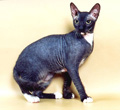
See also Brush. |
This is a type of coat in the Don Sphynx and Peterbald.
Usually Don Sphynx and Peterbald are naked. But there is a coat type which has a fine, soft and short down,
which can be felt - one feels a certain resistance when stroking with the hand over the skin. |
| Vibrissae |
Tactile hairs or whiskers.
Vibrissae can be found above the eye brows, as whiskers and on the backside of the front legs. |
| W |
Goto Top |
| White spotting
Siehe auch Piebald. |
The white patches, caused by the Piebald Spotting gene, are called white spotting.
See Bicolour, Tricolour, Piebald. |
| X |
Goto Top |
| Xiphisternum |
The lowest and smallest part of the three divisions of the breast bone (sternum).
This part is called so, because the bone is shaped like a sword. |